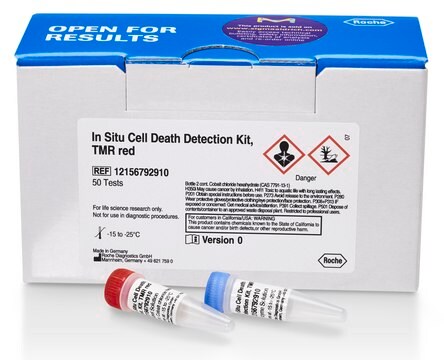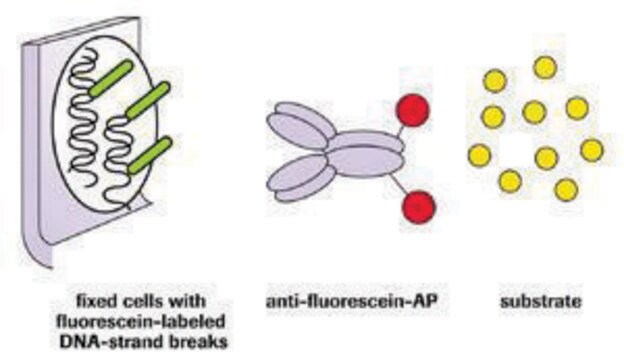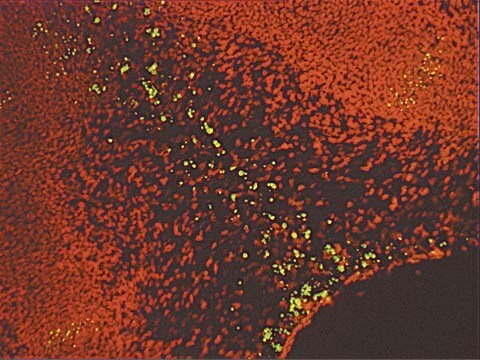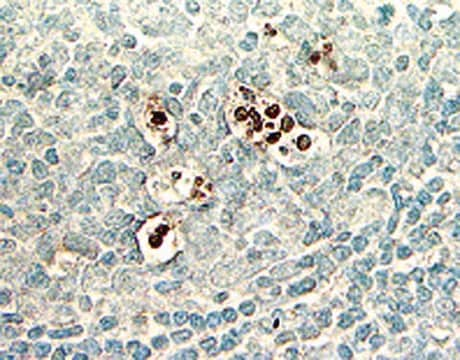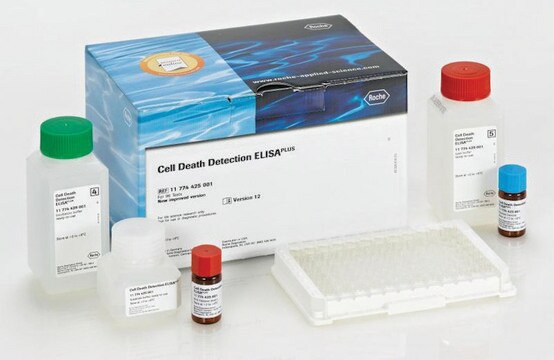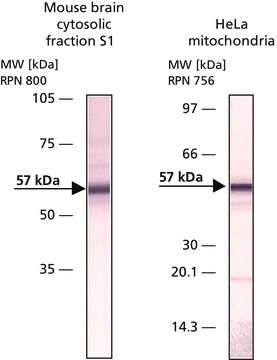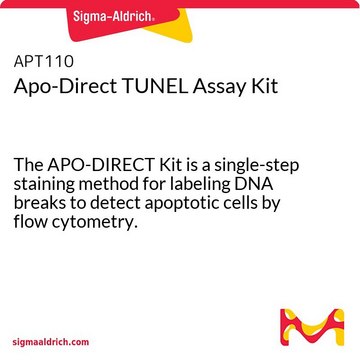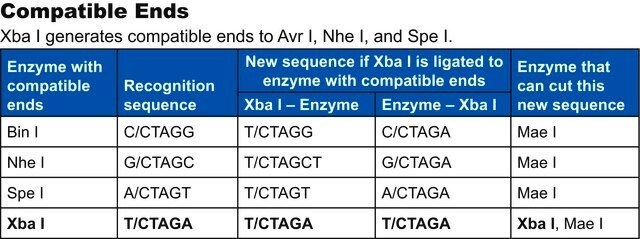11684817910
Roche
In Situ Cell Death Detection Kit, POD
sufficient for ≤50 tests
Synonym(s):
cell death
Sign Into View Organizational & Contract Pricing
All Photos(1)
About This Item
UNSPSC Code:
12352200
Recommended Products
usage
sufficient for ≤50 tests
Quality Level
manufacturer/tradename
Roche
technique(s)
immunohistochemistry: suitable
storage temp.
−20°C
Related Categories
General description
Kit for the detection and quantification of apoptotic cell death on a single-cell level by light microscopy in immunohistocytochemistry.
Application
The In Situ Cell Death Detection Kit, POD, is a precise, fast, and simple nonradioactive technique to detect and quantify apoptotic cell death at the single-cell level in cells and tissues. Thus, the In Situ Cell Death Detection Kit can be used in many different assay systems.
- Examples are: Detection of individual apoptotic cells in frozen, paraffin-embedded and formalin-fixed tissue sections in basic research and routine pathology
- Determination of sensitivity of malignant cells to drug-induced apoptosis in cancer research and clinical oncology
- Typing of cells undergoing cell death in heterogeneous populations by double staining procedures
Features and Benefits
Sensitive: The maximum intensity of labeling (cell staining) of apoptotic cells is higher than the nick translation method.
Fast: The use of fluorescein-dUTP allows analysis of the samples directly after the TUNEL reaction, but before the addition of the secondary detection system.
Convenient: The direct labeling procedure using fluorescein-dUTP allows verification of the efficiency of the TUNEL reaction during the assay procedure.
Accurate: Identification of apoptosis at a molecular level (DNA-strand breaks) and identification of cells at the very early stages of apoptosis.
Flexible: No substrate included; provides the opportunity to select the staining procedure of choice.
Fast: The use of fluorescein-dUTP allows analysis of the samples directly after the TUNEL reaction, but before the addition of the secondary detection system.
Convenient: The direct labeling procedure using fluorescein-dUTP allows verification of the efficiency of the TUNEL reaction during the assay procedure.
Accurate: Identification of apoptosis at a molecular level (DNA-strand breaks) and identification of cells at the very early stages of apoptosis.
Flexible: No substrate included; provides the opportunity to select the staining procedure of choice.
Packaging
1 kit containing 3 components.
Principle
The In Situ Cell Death Detection Kit, POD is based on the detection of single- and double-stranded DNA breaks that occur at the early stages of apoptosis.
Apoptotic cells are fixed and permeabilized. Subsequently, the cells are incubated with the TUNEL reaction mixture that contains TdT and fluorescein-dUTP. During this incubation period, TdT catalyzes the addition of fluorescein-dUTP at free 3′-OH groups in single- and double-stranded DNA. After washing, the label incorporated at the damaged sites of the DNA is marked by an anti-fluorescein antibody conjugated with the reporter enzyme peroxidase. After washing to remove unbound enzyme conjugate, the POD retained in the immune complex is visualized by a substrate reaction.
Apoptotic cells are fixed and permeabilized. Subsequently, the cells are incubated with the TUNEL reaction mixture that contains TdT and fluorescein-dUTP. During this incubation period, TdT catalyzes the addition of fluorescein-dUTP at free 3′-OH groups in single- and double-stranded DNA. After washing, the label incorporated at the damaged sites of the DNA is marked by an anti-fluorescein antibody conjugated with the reporter enzyme peroxidase. After washing to remove unbound enzyme conjugate, the POD retained in the immune complex is visualized by a substrate reaction.
Preparation Note
Storage conditions (working solution): TUNEL reaction mixture
The TUNEL reaction mixture should be prepared immediately before use and should not be stored. Keep TUNEL reaction mixture on ice until use.
Converter-peroxidase
Once thawed the Converter-peroxidase solution should be stored at 2 to 8 °C (maximum stability 6 months).
Note: Do not freeze.
Sample material: Cytospin and cell smear preparations, adherent cells grown on slides, and frozen and paraffin-embedded tissue sections.
The TUNEL reaction mixture should be prepared immediately before use and should not be stored. Keep TUNEL reaction mixture on ice until use.
Converter-peroxidase
Once thawed the Converter-peroxidase solution should be stored at 2 to 8 °C (maximum stability 6 months).
Note: Do not freeze.
Sample material: Cytospin and cell smear preparations, adherent cells grown on slides, and frozen and paraffin-embedded tissue sections.
Kit Components Only
Product No.
Description
- Enzyme Solution (TdT)
- Label Solution (fluorescein-dUTP)
- Converter Peroxidase (anti-fluorescein antibody-peroxidase) ready-to-use
Signal Word
Danger
Hazard Statements
Precautionary Statements
Hazard Classifications
Aquatic Chronic 2 - Carc. 1B Inhalation - Skin Sens. 1
Storage Class Code
6.1D - Non-combustible acute toxic Cat.3 / toxic hazardous materials or hazardous materials causing chronic effects
WGK
WGK 3
Flash Point(F)
does not flash
Flash Point(C)
does not flash
Choose from one of the most recent versions:
Already Own This Product?
Find documentation for the products that you have recently purchased in the Document Library.
Customers Also Viewed
Cuneyt Tayman et al.
Pediatric surgery international, 27(11), 1179-1189 (2011-06-29)
To determine the preventative effect of caffeic acid phenethyl ester (CAPE) in necrotizing enterocolitis (NEC) in an experimental rat model of NEC. Thirty newborn Sprague-Dawley rats were randomly divided into three groups; as NEC, NEC + CAPE and control. NEC
Stefanie Preuss et al.
Journal of cellular and molecular medicine, 16(11), 2813-2826 (2012-08-14)
Hypoxemic respiratory failure of the neonatal organism involves increased acid sphingomyelinase (aSMase) activity and production of ceramide, a second messenger of a pro-inflammatory pathway that promotes increased vascular permeability, surfactant alterations and alveolar epithelial apoptosis. We comparatively assessed the benefits
Sheng-chun Dang et al.
Journal of Zhejiang University. Science. B, 15(6), 556-565 (2014-06-07)
It has been shown that macrophages play an important role in the development of severe acute pancreatitis (SAP), and eventually lead to multiple organ failure (MOF). Clodronate-liposome selectively depleted macrophages. This study was to investigate the role of renal macrophage
Shuai Wu et al.
PloS one, 8(4), e61366-e61366 (2013-04-18)
Several studies suggest that mesenchymal stem cells (MSCs) possess antitumor properties; however, the exact mechanisms remain unclear. Recently, microvesicles (MVs) are considered as a novel avenue intercellular communication, which may be a mediator in MSCs-related antitumor effect. In the present
Sheng-Chun Dang et al.
World journal of gastroenterology, 21(9), 2651-2657 (2015-03-12)
To investigate the protective effect of clodronate-containing liposomes against severe acute pancreatitis (SAP)-triggered acute gastric mucosal injury (AGMI) in rats. Clodronate- and phosphate-buffered saline (PBS)-containing liposomes were prepared by reverse-phase evaporation. The SAP rat model was established by injecting sodium
Articles
Cellular apoptosis assays to detect programmed cell death using Annexin V, Caspase and TUNEL DNA fragmentation assays.
Our team of scientists has experience in all areas of research including Life Science, Material Science, Chemical Synthesis, Chromatography, Analytical and many others.
Contact Technical Service
